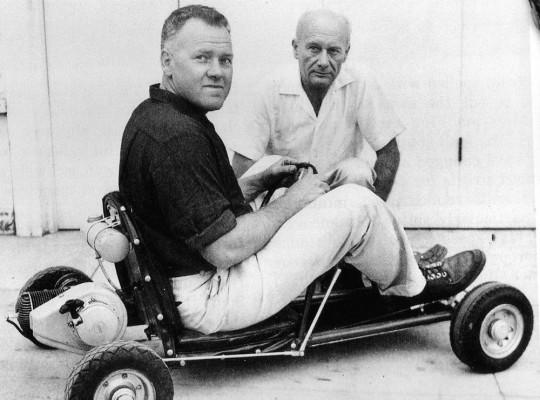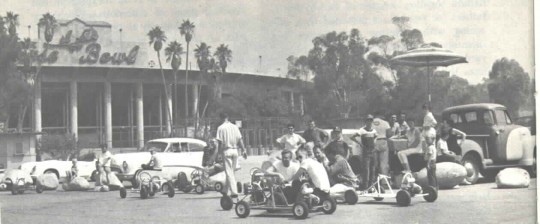As the automobiles evolved, the access of the regular Joe to the world of racing has become increasingly harder to attain. That meant that people passed their prime, as well as kids wanting to make a name for themselves, had to turn to something that would satisfy their needs.
In today’s world, aside for a recreational tool for adults, go-kart racing is a stepping stone for kid racers targeting higher-tier competitions the likes of Formula 4 and beyond. Over the years, a lot of names now famous in Formula 1 started their careers as drivers in go-karting: Nico Rosberg, Ayrton Senna, Lewis Hamilton or Michael Schumacher.
All the names above would have remained unheard of hadn’t it been for veteran hot rodder and a race car builder Art Ingels.THE FIRST KART
The first-ever go-kart was constructed by Ingels in 1956, with the help of Lou Borelli. They used for the build a West Bend 2-cycle 750 engine taken from a lawn mower, slapped it on top of an incredibly simple tubular chassis and adorned the entire machine with semi-pneumatic tires.
Officially, this go-kart has no name but is known in the world of kart enthusiasts as Kart No. 1, or The West Bend. The engine developed only 2 horsepower, delivered to the left rear wheel through a countershaft constructed of bicycle chains, sprockets, and a centrifugal clutch.
Braking was achieved by using a pulling a lever fitted on the right-hand side. The lever pivoted a plate which pressed a braking pad against a disc welded to the right rear rim.
This first kart was rarely used in racing, but when it drove Ingels himself to and fro, it managed to attract a lot of interest. The first public appearance of the model took place the same year, at the Pomona sports car races.
Three Californians saw the potential of the machine and decided to manufacture karts on a large scale.
 BIRTH OF THE GO-KART
BIRTH OF THE GO-KART
One year after Ingels innovated the go-kart, Bill Rowles, Duffy Livingstone, and Roy Desbrow established the Go-Kart Manufacturing Company. The three set out to create their own karts, using a seemingly endless supply of inexpensive engines scavenged from a bankrupt West Bend lawn mower business.
The three men decided to sell the karts as kits for $129. To better describe their product, it has been named Go-Kart.
As the success of Go-Kart Manufacturing grew, more and more companies began doing what they did. The inventor of the kart, Art Ingels, set up his own kart building business together with the man who helped him construct the first kart, giving birth to the Ingels-Borelli Kart company. The two, together with other such companies, began to coalesce in the American Kart Manufacturer's Association. CARETTA
As said, Art Ingels and Lou Borelli set up their own kart manufacturing company, the Ingels & Borelli Kart Company. This would become the world’s first producer of completed karts, which were sold under the name Caretta.
The Caretta kart, hand-built, has become the forefather of the current enduro karts used in competitions. BIRTH OF IKF
 As soon as Livingstone saw Ingels’ creation and built his own, he began meeting with the inventor of the original machine at the Rose Bowl parking lot, in Pasadena. There they would hold various types of races and competitions.
As soon as Livingstone saw Ingels’ creation and built his own, he began meeting with the inventor of the original machine at the Rose Bowl parking lot, in Pasadena. There they would hold various types of races and competitions.
As more and more people were drawn to this new segment of racing, an increasing variety of karts started to pop up. Those who wanted to race but had no building skills began demanding to purchase go-karts, fueling the success of the two companies.
As a result of an increasing number of kart racers, some guidelines had to be created. The rules and regulations governing go-kart racing were put together by Pasadena attorney Don Broberick. He, along with twelve other enthusiasts, set up the Go Kart Club of America, which in time would become the International Karting Federation (IKF). GOING INTERNATIONAL
Despite all these little vital steps, this new sport was little known outside California. Luckily for karting, Spencer Murray, a writer from Rod & Custom magazine, decided to support karting by publishing a special magazine in 1958. The sports became an instant hit and significant competitions were on the way.
The first Grand National event took place in 1959 at the Azusa track in California. Starting with 1962, the sport has become regulated by FIA and the annual Karting World Championship was set up.
Currently, there are a considerable number of go-kart competitions organized across the globe. Racers come together in clubs or associations. For them to be able to compete, they require a license as well as proper protection equipment, a taste of the requirements of more prestigious racing series..








